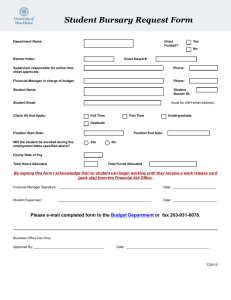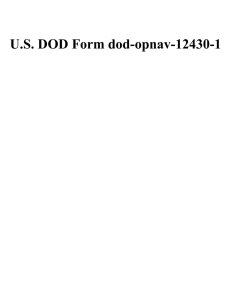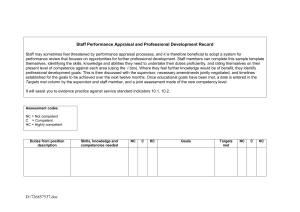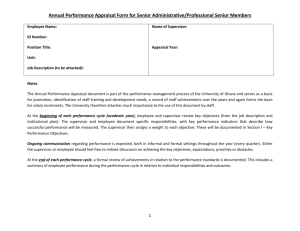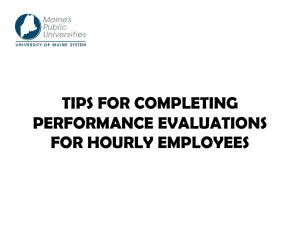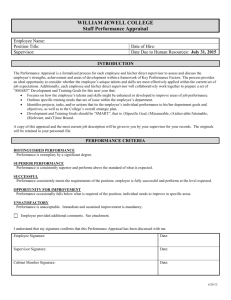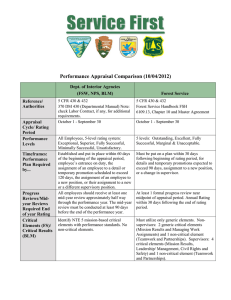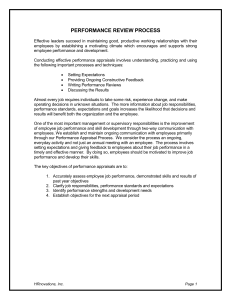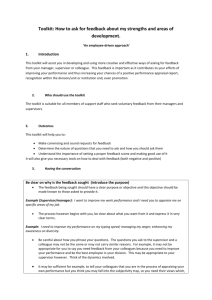PREPARING FOR THE PERFORMANCE ASSESSMENT
advertisement
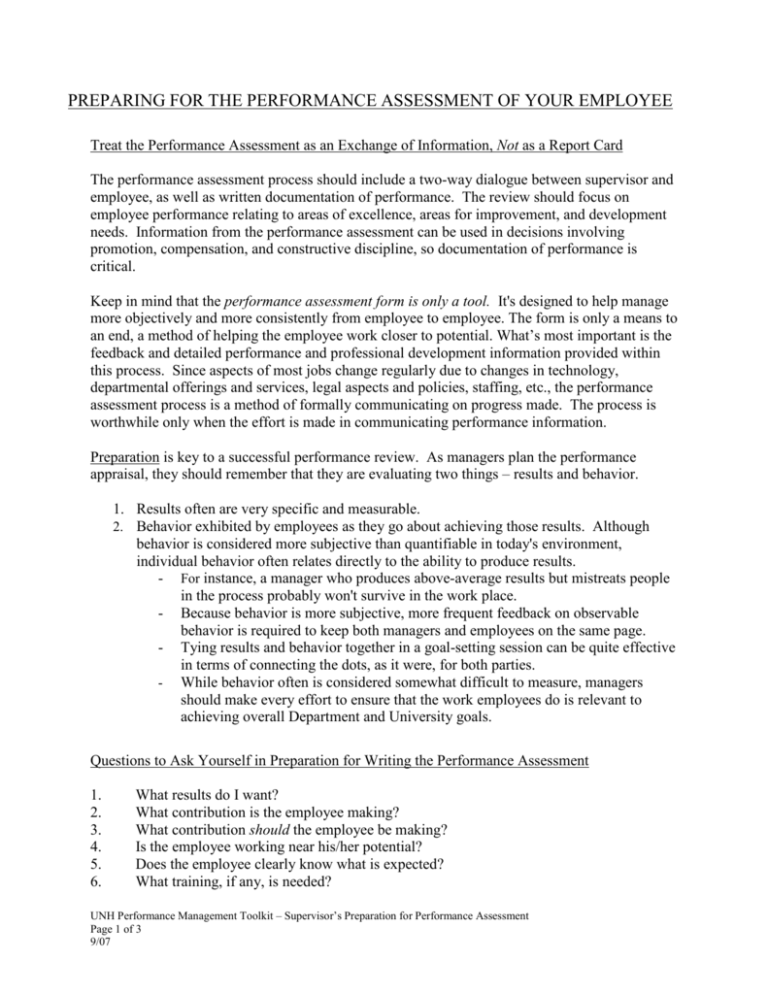
PREPARING FOR THE PERFORMANCE ASSESSMENT OF YOUR EMPLOYEE Treat the Performance Assessment as an Exchange of Information, Not as a Report Card The performance assessment process should include a two-way dialogue between supervisor and employee, as well as written documentation of performance. The review should focus on employee performance relating to areas of excellence, areas for improvement, and development needs. Information from the performance assessment can be used in decisions involving promotion, compensation, and constructive discipline, so documentation of performance is critical. Keep in mind that the performance assessment form is only a tool. It's designed to help manage more objectively and more consistently from employee to employee. The form is only a means to an end, a method of helping the employee work closer to potential. What’s most important is the feedback and detailed performance and professional development information provided within this process. Since aspects of most jobs change regularly due to changes in technology, departmental offerings and services, legal aspects and policies, staffing, etc., the performance assessment process is a method of formally communicating on progress made. The process is worthwhile only when the effort is made in communicating performance information. Preparation is key to a successful performance review. As managers plan the performance appraisal, they should remember that they are evaluating two things – results and behavior. 1. Results often are very specific and measurable. 2. Behavior exhibited by employees as they go about achieving those results. Although behavior is considered more subjective than quantifiable in today's environment, individual behavior often relates directly to the ability to produce results. - For instance, a manager who produces above-average results but mistreats people in the process probably won't survive in the work place. - Because behavior is more subjective, more frequent feedback on observable behavior is required to keep both managers and employees on the same page. - Tying results and behavior together in a goal-setting session can be quite effective in terms of connecting the dots, as it were, for both parties. - While behavior often is considered somewhat difficult to measure, managers should make every effort to ensure that the work employees do is relevant to achieving overall Department and University goals. Questions to Ask Yourself in Preparation for Writing the Performance Assessment 1. 2. 3. 4. 5. 6. What results do I want? What contribution is the employee making? What contribution should the employee be making? Is the employee working near his/her potential? Does the employee clearly know what is expected? What training, if any, is needed? UNH Performance Management Toolkit – Supervisor’s Preparation for Performance Assessment Page 1 of 3 9/07 7. 8. What are the employee’s strengths? How has my performance helped or hindered the employee? Pointers for the Performance Assessment Process 1. Evaluate your own performance before evaluating that of your employee(s). Consider the question, “What can I do to help the employee do the job better and achieve developmental goals? 2. In preparation for the assessment gather as much information as possible: • job description of employee • performance standards • previous performance appraisals • performance goals agreed upon for this evaluation period • letters of commendation and/or criticism • input from others (peers, customers) • samples of work • documentation compiled throughout the year (positive as well as problem areas) • records of disciplinary action 3. There should be a close correlation between the employee’s job description and the appraisal criteria 4. Be candid and specific with evaluation remarks 5. Don’t focus predominately on a specific problem; evaluation should encompass all performance areas 6. There should be no surprises for the employee 7. Include performance improvement plan 8. Be open to dialogue, to hearing employee’s comments. The employee should have no fear of reprisal for expressing their view. 9. Remember to follow up on the appraisal discussion with the employee during the Be Aware of Bias - Perceptual Biases to Avoid Self-awareness is a key to good information gathering and discussions. Supervisors sometimes make these mistakes partly because their emotions run high when in performance management discussions. Here are some of the performance decision and discussion pitfalls to avoid: Overconfidence in Your Judgment - Failing to collect key factual information because you are too sure of your assumptions and opinions UNH Performance Management Toolkit – Supervisor’s Preparation for Performance Assessment Page 2 of 3 9/07 Shortsighted Shortcuts - Relying inappropriately on "rules of thumb" such as implicitly trusting the most readily available information or anchoring on convenient facts Shooting from the Hip - Believing you can keep straight in your head all the information you've discovered, and therefore "winging it" rather than following a systematic procedure when making decisions and conducting discussions Primacy Effect - Heavy influence of first impression Recency Effect – Reviewing only the most recent performance and not taking into account events throughout the year Halo Effect (Leniency error) – Allowing excellent performance in one area to overshadow the review of performance in other areas Horns effect (Harshness error) – Allowing unsatisfactory or marginal performance in one area to overshadow the review of performance in other areas Central tendency error – Selecting a “middle of the road” or average rating to describe all performance without regard to actual data and observations Low tolerance error - Rating everyone low because of excessively high standards High tolerance error – Rating everyone high because of wanting to avoid conflict or hurt anyone’s feelings Contrast Error – Ratings based on comparisons rather than measuring true performance Similar to Me Effects - We like people similar to ourselves better than those dissimilar Stereotypes - All members of certain groups possess the same traits/behavior Frames of Reference - Previous experience/our own realities may dictate how we respond Following are methods for avoiding errors in bias: • • • • Keep documentation (notes, email, etc.) throughout the year, both on accomplishments and needs for improvement Suggest your employee keep documentation also Allow sufficient time before the review meeting to thoroughly prepare, carefully reflecting on the events of the past year Ask the employee to review his or her own performance for input in the discussion UNH Performance Management Toolkit – Supervisor’s Preparation for Performance Assessment Page 3 of 3 9/07
